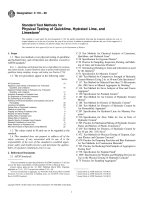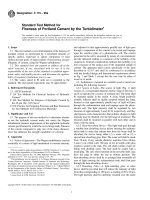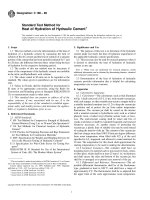Designation: C 185 – 01 - Air Content of Hydraulic Cement Mortar1 ppsx
Bạn đang xem bản rút gọn của tài liệu. Xem và tải ngay bản đầy đủ của tài liệu tại đây (24.67 KB, 3 trang )
Designation: C 185 – 01 American Association State
Highway and Transportation Officials Standard
AASHTO No.: T137
Standard Test Method for
Air Content of Hydraulic Cement Mortar
1
This standard is issued under the fixed designation C 185; the number immediately following the designation indicates the year of
original adoption or, in the case of revision, the year of last revision. A number in parentheses indicates the year of last reapproval. A
superscript epsilon (e) indicates an editorial change since the last revision or reapproval.
This standard has been approved for use by agencies of the Department of Defense.
1. Scope
1.1 This test method covers the determination of the air
content of hydraulic cement mortar under the conditions
hereinafter specified.
1.2 The values stated in SI units are to be regarded as the
standard.
1.3 Values in SI shall be obtained by measurement in SI
units or by appropriate conversion, using the Rules for Con-
version and Rounding in IEEE/ASTM SI 10, of measurements
made in other units.
1.4 This standard does not purport to address all of the
safety concerns, if any, associated with its use. It is the
responsibility of the user of this standard to establish appro-
priate safety and health practices and determine the applica-
bility of regulatory limitations prior to use.
1.5 Warning— Fresh hydraulic cementitious mixtures are
caustic and may cause chemical burns to skin and tissue upon
prolonged exposure.
2
2. Referenced Documents
2.1 ASTM Standards:
C 91 Specification for Masonry Cement
3
C 109 Test Method for Compressive Strength of Hydraulic-
Cement Mortars (Using 2-in. or [50-mm] Cube Speci-
mens)
3
C 183 Practice for Sampling and the Amount of Testing of
Hydraulic Cement
3
C 230 Specification for Flow Table for Use in Tests of
Hydraulic Cement
3
C 305 Practice for Mechanical Mixing of Hydraulic Cement
Pastes and Mortars of Plastic Consistency
3
C 511 Specification for Moist Cabinets, Moist Rooms, and
Water Storage Tanks Used in the Testing of Hydraulic
Cements and Concretes
3
C 778 Specification for Standard Sand
3
C 1005 Specification for Weights and Weighing Devices for
Use in the Physical Testing of Hydraulic Cements
3
E 438 Specification for Glasses in Laboratory Apparatus
4
E 694 Specification for Laboratory Glass Volumetric Appa-
ratus
4
IEEE/ASTM SI 10 Standard for Use of the International
System of Units (SI): The Modern Metric System
4
3. Summary of Test Method
3.1 Prepare a mortar with standard sand and the cement to
be tested, using a water content sufficient to give a required
flow. Compact the mortar into a measure of known volume and
determine mass. Calculate the air content from the measured
density of the mortar, the known densities of the constituents,
and the mixture proportions.
4. Significance and Use
4.1 The purpose of this test method is to determine whether
or not the hydraulic cement under test meets the air-entraining
or non-air-entraining requirements of the applicable hydraulic
cement specification for which the test is being made. The air
content of concrete is influenced by many factors other than the
potential of the cement for air entrainment.
5. Apparatus
5.1 Flow Table, Flow Mold, and Caliper, shall conform to
Specification C 230.
5.2 Measure—A cylindrical measure having an inside di-
ameter of 76 6 2 mm and a depth (approximately 88 mm)
adjusted by standardization with water to contain 400 6 1mL
at 23.0 6 2.0°C (Note 1). For the purposes of this test, the
capacity of the measure in millilitres is the mass of the water
content of the measure, in grams, divided by 0.9976, no
correction in mass being made for the buoyant effect of air. The
measure shall have a uniform wall thickness. The thickness of
the wall and bottom shall not be less than 2.9 mm. The total
mass of the empty measure shall not be more than 900 g. The
measure shall be made of a metal not attacked by the cement
mortar.
NOTE 1—Calibrate the 400-mL measure by filling with distilled water
at 23.06 2.0°C to a point where the meniscus extends appreciably above
the top of the measure, placing a clean piece of plate glass on the top of
the measure, and allowing the excess water to be squeezed out. The
absence of air bubbles as seen through the glass ensures that the measure
1
This test method is under the jurisdiction of ASTM Committee C01 on Cement
and is the direct responsibility of Subcommittee C01.21 on Air Entrainment.
Current edition approved Jan. 10, 2001. Published January 2001. Originally
published as C 185 – 44 T. Last previous edition C 185 – 99.
2
Refer to the section on Safety Precautions, “Manual of Cement Testing,”
Annual Book of ASTM Standards, Vol 04.01.
3
Annual Book of ASTM Standards, Vol 04.01.
4
Annual Book of ASTM Standards, Vol 14.02.
1
Copyright © ASTM, 100 Barr Harbor Drive, West Conshohocken, PA 19428-2959, United States.
is completely full. Care shall be taken that the excess water is wiped from
the sides of the container before weighing.
5.3 Mixer, Bowl, and Paddle, shall conform to the apparatus
section of Practice C 305.
5.4 Straightedge—A steel straightedge not less than 200
mm long and not less than 1.5 mm nor more than 3.5 mm in
thickness.
5.5 Weights and Weighing Devices, shall conform to Speci-
fication C 1005. Evaluate the weighing device for precision
and accuracy at a total load of 2 kg.
5.6 Glass Graduates—Glass graduates of 250-mL capacity,
conforming to the requirements of Specifications E 438 and
E 694.
5.7 Tamper, conforming to the requirements of Test Method
C 109. The tamping face of the tamper shall be flat and at right
angles to the length of the tamper.
5.8 Tapping Stick, a piece of hard wood having a diameter
of approximately 16 mm and a length of approximately 152
mm.
5.9 Spoon—A metal restaurant-type serving spoon not less
than 230 mm in length and with a bowl approximately 100 mm
in length.
6. Temperature and Humidity
6.1 Maintain the temperature of the room and dry materials
at 23.0 6 4.0 °C.
6.2 Condition the mixing water and the measure, if it is
being calibrated at 23 6 2°C.
6.3 Maintain the relative humidity of the laboratory at not
less than 50 %.
7. Standard Sand
7.1 Use sand conforming to the requirements of Specifica-
tion C 778 for 20–30 sand.
8. Sampling
8.1 Sample the cement in accordance with Practice C 183.
9. Procedure
9.1 Batch—Proportion the standard mortar using 350 g
cement to 1400 g 20–30 standard sand and sufficient water to
give a flow of 87
1
⁄
2
6 7
1
⁄
2
% when determined in accordance
with 9.3.
NOTE 2—Masonry cements require different sand, sample mass, and
flow. Refer to Specification C 91.
9.2 Mixing of Mortar—Mix the mortar in accordance with
Practice C 305.
9.3 Flow Determination—Carefully wipe dry the flow-table
top and place the flow mold at the center of it. Using the spoon,
place a layer of mortar about 25 mm in thickness in the mold
and tamp 20 times with the tamper. The tamping pressure shall
be just sufficient to ensure uniform filling of the mold. Overfill
the top of the mold approximately 20 mm with mortar and
tamp as specified for the first layer. Then cut off the mortar to
a plane surface, flush with the top of the mold, by drawing the
straightedge with a sawing motion across the top of the mold.
Wipe the flow table top clean and dry, being especially careful
to remove any water from around the edge of the mold. Lift the
mold away from the mortar 1 min after completing the mixing
operation. Immediately drop the table 10 times in accordance
with Specification C 230. The flow is the resulting increase in
average diameter of the mortar mass, as determined with the
calipers, measured on at least four diameters at approximately
equispaced intervals, expressed as a percentage of the original
diameter. Make trial mortars with varying percentages of water
until the specified flow is obtained. Make each trial with fresh
mortar.
9.4 Mass per 400 mL of Mortar—When the quantity of
mixing water has been found that produces a flow of 87
1
⁄
2
6
7
1
⁄
2
%, immediately determine the mass per 400 mL of mortar,
using the mortar remaining in the mixing bowl after the flow
has been determined. In the determination of the mass per 400
mL, do not use the portion of the mortar used in the flow
determination. Using the spoon, place the mortar gently into
the 400–ml measure in three equal layers. Tamp each layer 20
times around the inner surface of the measure. For the final
layer of mortar, overfill the 400–ml measure approximately 20
mm. The position of the tamper shall be that: the broad side of
the tamper is parallel to the radius and is perpendicular to the
inner surface of the measure. Each layer is tamped in one
complete revolution (rotation) with only sufficient pressure to
adequately fill the measure and eliminate voids within the
mortar. After the measure has been filled and tamped in the
above prescribed manner, tap the sides of the measure lightly
with the side of the tapping stick, one each at five different
points at approximately equal spacing around the outside of the
measure, in order to preclude entrapment of extraneous air
(Note 3). No obvious space shall be left between the mortar
and the inner surface of the measure as a result of the tamping
operation. Then cut the mortar off to a plane surface, flush with
the top of the measure, by drawing the straightedge with a
sawing motion across the top of the measure, making two
passes over the entire surface, the second pass being made at
right angles to the first. If, in the striking-off operation, loose
sand grains cause the straightedge to ride above the top surface
of the measure, these grains shall be removed, and the
operation repeated. Complete the entire operation of filling and
striking off the measure within 1
1
⁄
2
min. Wipe off all mortar and
water adhering to the outside of the measure. Determine the
mass of the measure and its contents. Subtract the mass of the
container, and record the mass of the mortar in grams.
NOTE 3—This operation may be facilitated by placing the measure on
a steady flat-surfaced support of lesser diameter than the measure while
filling and wiping.
10. Calculation
10.1 Calculate the air content of the mortar from the
following formula which is based on the batch proportions
given in 9.1, taking the specific gravity of portland cement as
3.15 and of 20–30 standard sand as 2.65. When the hydraulic
cement is other than portland, the appropriate value for its
specific gravity shall be substituted for the value of 3.15 and
the formula rederived accordingly:
C 185
2
Air content, volume % 5 100 2 W
@~
182.7 1 P
!
/
~
2000 1 4P
!
#
(1)
where:
W = mass of 400 mL of mortar, g, and
P = percentage of mixing water, based on mass of cement
used.
NOTE 4—This formula is derived as follows:
Air content, volume % 5 100
@
1 2
~
W
a
/W
c
!
#
(2)
where:
W
a
= actual mass per unit of volume as determined by this
test method.
= W/400 g/mL, where W is the mass in grams of the
specified 400 mL of mortar (9.4),
W
c
= theoretical mass per unit of volume, calculated on an
air-free basis as follows and using the values for
quantities of materials and specific gravities as given
in 9.1 and 10.1,
=
350 1 1400 1 350 3 P 3 0.01
350
3.15
1
1400
2.65
1
350 3 P 3 0.01
1
=
~
5 1 0.01P
!
~
1.827 1 0.01P
!
, and
P = percentage of mixing water, based on mass of ce-
ment.
Substituting for W
a
and W
c
we have:
Air content, volume % 5 100
S
1 2
W
400
3
1.827 1 0.01P
5 1 0.01P
D
Air content, volume % 5 100 2
W
4
3
~
1.827 1 0.01P
!
~
5 1 0.01P
!
Air content, volume % 5 100 2 2.5W
~
182.7 1 P
!
~
5000 1 10P
!
Air content, volume % 5 100 2 W
~
182.7 1 P
!
~
2000 1 4P
!
10.2 Make only one determination of air content on a batch.
NOTE 5—Difficulty has occasionally been experienced with this test
method by some persons. These difficulties usually have taken the form of
values for air content that are abnormally high and that may be greater
than the specified maxima in specifications for hydraulic cement. The
air-entraining potential of the sand may be reduced by washing in the
laboratory with potable water by decantation until a clear, colorless
supernatant liquid is obtained. In case of dispute, such freshly washed
sand shall be used.
11. Report
11.1 When this test method is used for specific action in
compliance testing, report the value for the air content to the
nearest 1 %.
12. Precision and Bias
12.1 The single-operator, within-laboratory, standard devia-
tion has been found to be 0.56 % air content throughout the
range of 8 to 19 % air. Therefore, results of two properly
conducted tests by the same operator on similar batches should
not differ by more than 1.6 % air.
12.2 The multilaboratory standard deviation has been found
to be 1.0 % air content throughout the range from 8 to 19 % air.
Therefore, results of two different laboratories on similar
batches should not differ from each other by more than 2.8 %
air.
13. Keywords
13.1 air content; hydraulic cement mortar
For additional useful information on details of cement tests methods, references may be made to the “Manual of
Cement Testing,” which appears in the Annual Book of ASTM Standards, Vol 04.01.
The American Society for Testing and Materials takes no position respecting the validity of any patent rights asserted in connection
with any item mentioned in this standard. Users of this standard are expressly advised that determination of the validity of any such
patent rights, and the risk of infringement of such rights, are entirely their own responsibility.
This standard is subject to revision at any time by the responsible technical committee and must be reviewed every five years and
if not revised, either reapproved or withdrawn. Your comments are invited either for revision of this standard or for additional standards
and should be addressed to ASTM Headquarters. Your comments will receive careful consideration at a meeting of the responsible
technical committee, which you may attend. If you feel that your comments have not received a fair hearing you should make your
views known to the ASTM Committee on Standards, at the address shown below.
This standard is copyrighted by ASTM, 100 Barr Harbor Drive, PO Box C700, West Conshohocken, PA 19428-2959, United States.
Individual reprints (single or multiple copies) of this standard may be obtained by contacting ASTM at the above address or at
610-832-9585 (phone), 610-832-9555 (fax), or (e-mail); or through the ASTM website (www.astm.org).
C 185
3
![Standard Test Method for Compressive Strength of Hydraulic Cement Mortars (Using 2-in. or [50-mm] Cube Specimens)](https://media.store123doc.com/images/document/14/rc/yi/medium_yil1395845738.jpg)

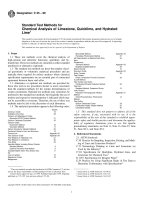
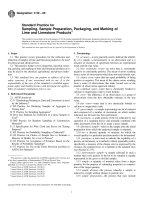
![Designation: C 109/C 109M – 99 - Compressive Strength of Hydraulic Cement Mortars (Using 2-in. or [50-mm] Cube Specimens)1 pps](https://media.store123doc.com/images/document/2014_07/10/medium_tyk1405009245.jpg)
